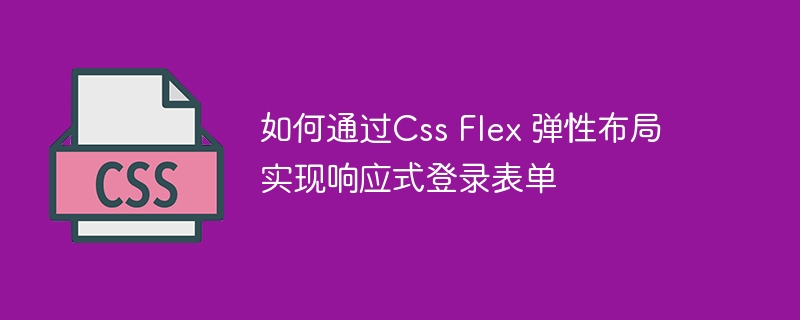

How to implement a responsive login form through CSS Flex elastic layout
In modern web design, responsive design has become an indispensable part. As more and more users access the web on different devices, we need to ensure that web pages adapt to different screen sizes and device orientations. CSS Flex is an excellent tool that can help us create responsive layouts and flexible web elements.
This article will introduce how to implement a responsive login form by using CSS Flex elastic layout. I'll provide specific code examples to help readers better understand how to apply this technique.
First, let’s create the HTML structure of a basic login form. The code is as follows:
<div class="login-form">
<h2>用户登录</h2>
<form>
<input type="text" placeholder="用户名">
<input type="password" placeholder="密码">
<button type="submit">登录</button>
</form>
</div>Next, we will use CSS Flex elastic layout to layout this form. Add the following code to the CSS file:
.login-form {
display: flex;
flex-direction: column;
align-items: center;
justify-content: center;
height: 100vh;
}
.login-form h2 {
margin-bottom: 20px;
}
.login-form form {
display: flex;
flex-direction: column;
align-items: center;
}
.login-form input,
.login-form button {
margin-bottom: 10px;
width: 200px;
}
.login-form button {
padding: 10px;
}Through the above code, we set the login form container to flex layout and set the main axis direction to vertical (column), so that the elements in the form will be arranged in the vertical direction . By setting align-items and justify-content to center, we center the elements within the form container horizontally and vertically.
Next, add the following media query code in the CSS file to enable the form to adapt to different screen sizes:
@media screen and (max-width: 600px) {
.login-form input,
.login-form button {
width: 100%;
}
}The above code indicates that when the screen width is less than 600px , the width of the input box and button in the login form will be set to occupy 100% of the entire container.
With these codes, we have successfully implemented a responsive login form. When the page is accessed on different devices, the form automatically adjusts its layout according to the screen size.
In actual development, we can also make more style adjustments and layout optimization to the form according to actual needs. For example, you can add a background image to the form, adjust the border style of the input box, etc. CSS Flex elastic layout provides rich properties and functions that can help us create complex and flexible layouts.
To summarize, by using CSS Flex elastic layout, we can easily implement a responsive login form. By having the flexibility to adjust layout and styling, we can ensure that our forms present the best user experience across different devices. I hope this article can be helpful to readers when using CSS Flex to create responsive layouts!
The above is the detailed content of How to implement a responsive login form through CSS Flex layout. For more information, please follow other related articles on the PHP Chinese website!
 Why do the words after typing in word disappear?
Why do the words after typing in word disappear?
 How to use the month function
How to use the month function
 Usage of setInterval in JS
Usage of setInterval in JS
 Tutorial on making inscribed coins
Tutorial on making inscribed coins
 Cost-effectiveness analysis of learning python, java and c++
Cost-effectiveness analysis of learning python, java and c++
 Introduction to frequency converter maintenance methods
Introduction to frequency converter maintenance methods
 How to use fusioncharts.js
How to use fusioncharts.js
 How many types of usb interfaces are there?
How many types of usb interfaces are there?




